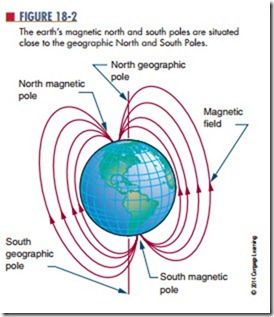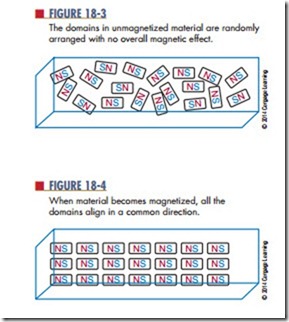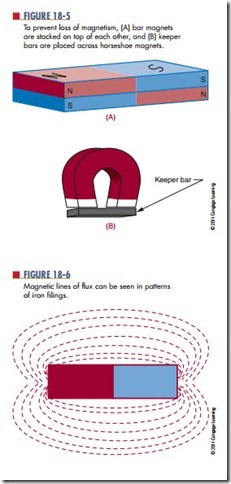Electric current always produces some form of magnetism, and magnetism is the most common method for generating electricity. In addition, electricity behaves in specific ways under the influence of magnetism.
This chapter looks at magnetism, electromagnetism, and the relationship between magnetism and electricity.
Magnetic Fields
The word magnet is derived from magnetite, the name of a mineral found in Magnesia, a part of Asia Minor. This mineral is a natural magnet. Another type of magnet is the artificial magnet. This mag- net is created by rubbing a piece of soft iron with a piece of magnetite. A third type of magnet is the electromagnet created by current flowing through a coil of wire.
Magnets come in various shapes (Figure 18-1). Among the more common shapes are the horseshoe, the bar or rectangle, and the ring.
Magnets that retain their magnetic properties are called permanent magnets. Magnets that retain only a small portion of their magnetic properties are called temporary magnets.
Magnets are made of metallic or ceramic materials. Alnico (aluminum, nickel, and cobalt) and Cunife
(copper [Cu], nickel, and Iron [Fe]) are two metallic alloys used for magnets.
The earth itself is a huge magnet (Figure 18-2). The earth’s magnetic north and south poles are situ- ated close to the geographic North and South Poles. If a bar magnet is suspended, the magnet aligns in a north–south direction, with one end pointing toward the North Pole of the earth and the other toward the South Pole. This is the principle behind the compass. It is also the reason the two ends of the magnet are called the north pole and the south pole.
Magnets align in a north–south direction be- cause of laws similar to those of positive and negative charges: Unlike magnetic poles attract each other and like magnetic poles repel each other. The color code for a magnet is red for the north pole and blue for the south pole.
Magnetism, the property of the magnet, can be traced to the atom. As electrons orbit around the nucleus of the atom, they spin on their axis, like the earth as it orbits the sun. This moving electrostatic charge produces a magnetic field. The direction of the magnetic field depends on the electron’s direction of spin. Iron, nickel, and cobalt are the only naturally magnetic elements. Each of these materials has two valence
electrons that spin in the same direction. Electrons in other materials tend to spin in opposite directions and this cancels their magnetic characteristics.
Ferromagnetic materials are materials that respond to magnetic fields. In ferromagnetic materials, the atoms combine into domains, or groups of atoms arranged in the form of magnets. In an unmagnetized material, the magnetic domains are randomly arranged, and the net magnetic effect is zero (Figure 18-3). When the material becomes magnetized, the domains align in a common direction and the material becomes a magnet (Figure 18-4). If the magnetized material is divided into smaller pieces, each piece becomes a magnet with its own poles.
Evidence of this “domain theory” is that if a magnet is heated or hit repeatedly with a hammer, it loses its magnetism (the domains are jarred back into a random arrangement). Also, if an artificial magnet is left by itself, it slowly loses its magnetism. To prevent this loss, bar magnets should be stacked on top of each other with opposite poles together; keeper bars should be placed across horseshoe magnets (Figure 18-5). Both methods maintain the magnetic field.
A magnetic field consists of invisible lines of force that surround a magnet. These lines of force are called
flux lines. They can be “seen” by placing a sheet of paper over a magnet and sprinkling iron filings on the paper. When the paper is lightly tapped, the iron filings arrange themselves into a definite pattern that reflects the forces attracting them (Figure 18-6).
Copyright 2013 Cengage Learning. All Rights Reserved. May not be copied, scanned, or duplicated, in whole or in part. Due to electronic rights, some third party content may be suppressed from the eBook and/or eChapter(s). Editorial review has deemed that any suppressed content does not materially affect the overall learning experience. Cengage Learning reserves the right to remove additional content at any time if subsequent rights restrictions require it.
Flux lines have several important characteristics: They have polarity from north to south. They always form a complete loop. They do not cross each other because like polarities repel. They tend to form the smallest loop possible, because unlike poles attract and tend to pull together.
The characteristic that determines whether a substance is ferromagnetic is called permeability. Permeability is the ability of a material to accept mag- netic lines of force. A material with great permeability offers less resistance to flux lines than air.
Questions
1. What are the three types of magnets?
2. What are the basic shapes of magnets?
3. How are the ends of a magnet identified?
4. What are the two laws of magnetism?
5. What are flux lines?



